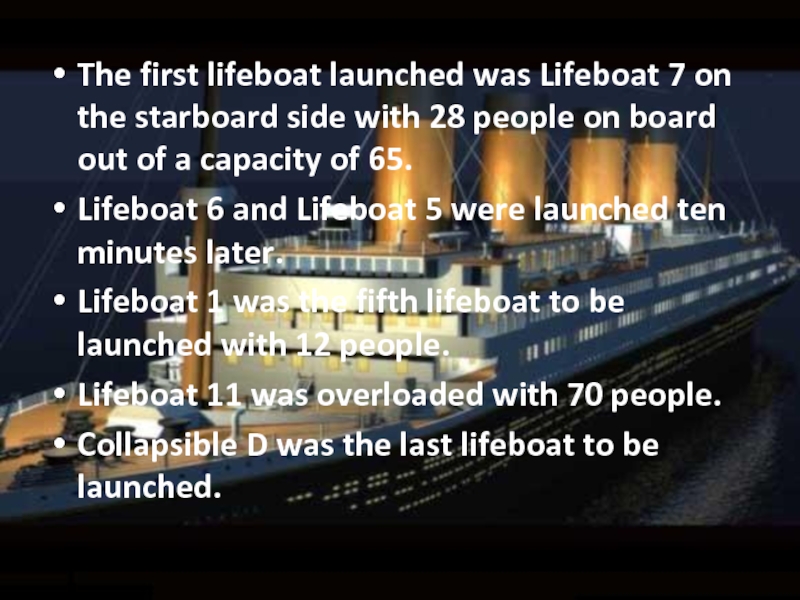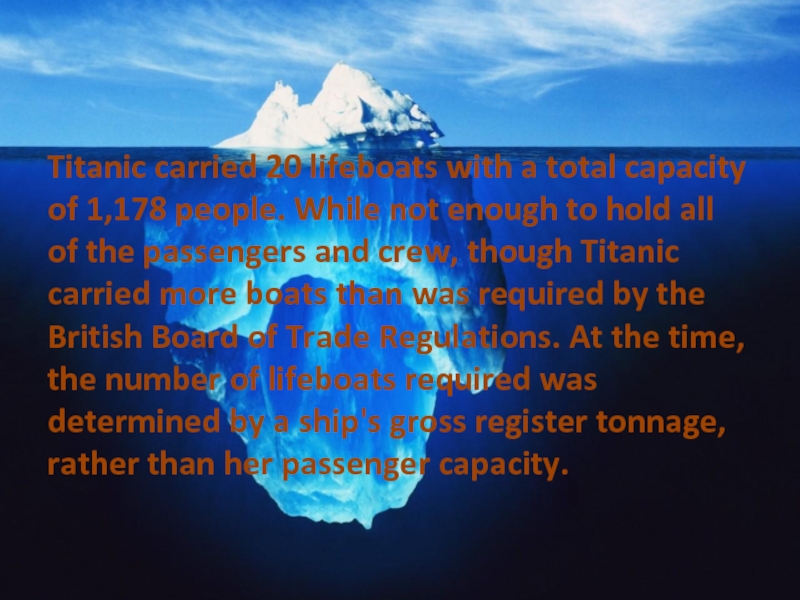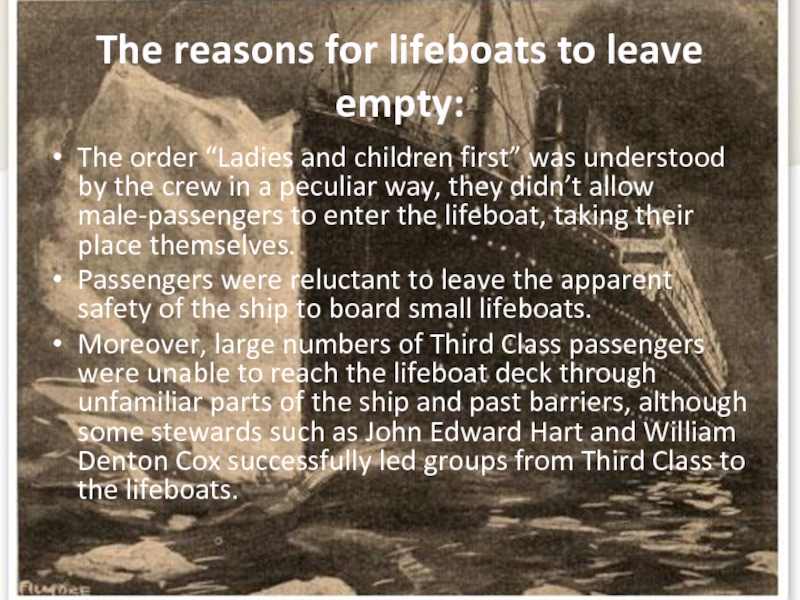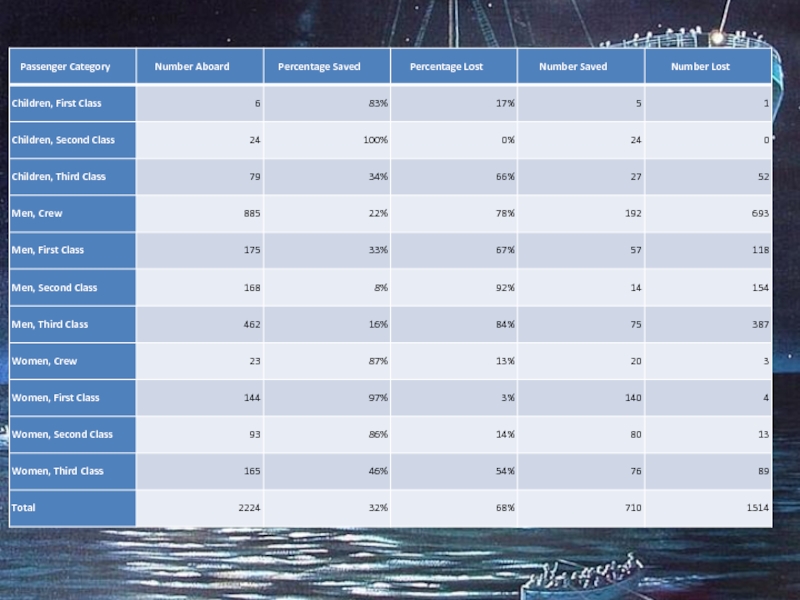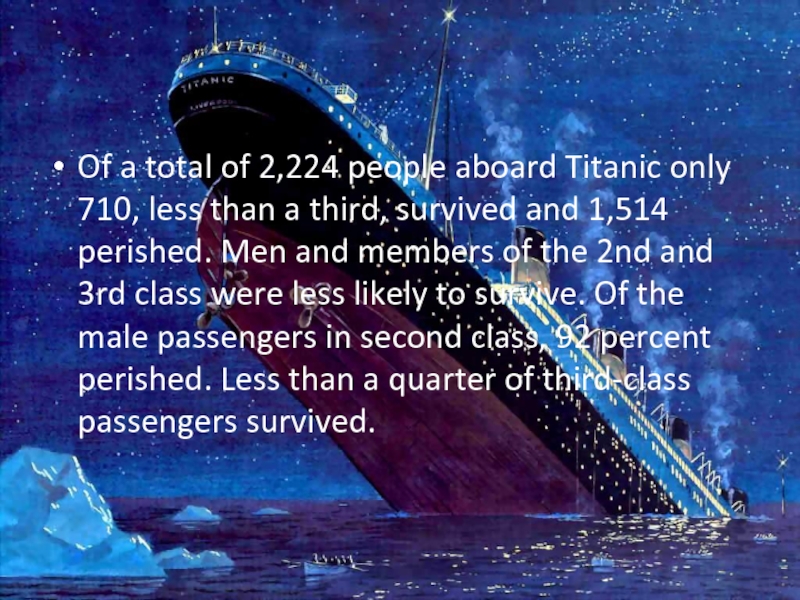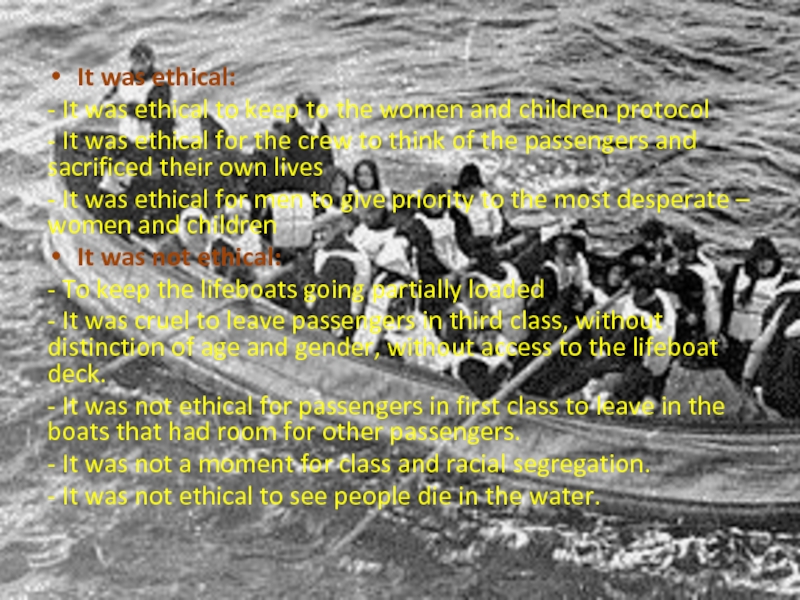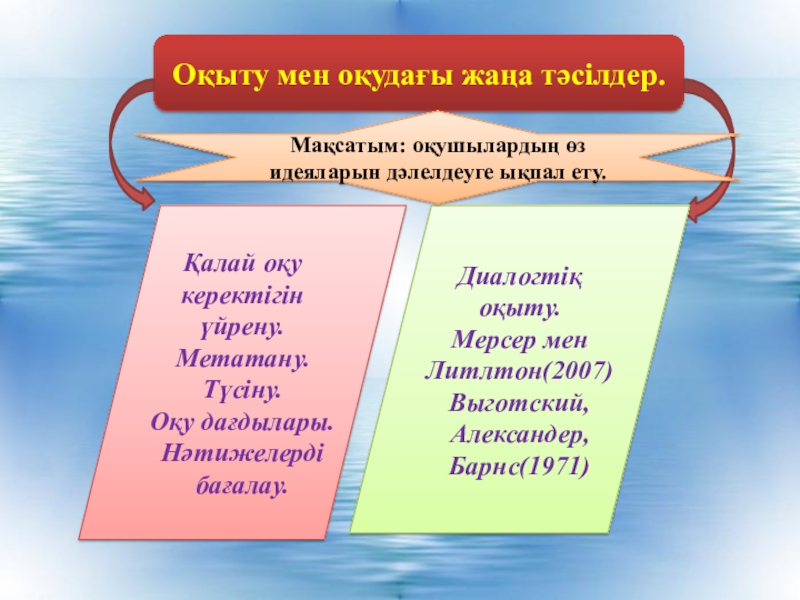Разделы презентаций
- Разное
- Английский язык
- Астрономия
- Алгебра
- Биология
- География
- Геометрия
- Детские презентации
- Информатика
- История
- Литература
- Математика
- Медицина
- Менеджмент
- Музыка
- МХК
- Немецкий язык
- ОБЖ
- Обществознание
- Окружающий мир
- Педагогика
- Русский язык
- Технология
- Физика
- Философия
- Химия
- Шаблоны, картинки для презентаций
- Экология
- Экономика
- Юриспруденция
Titanic
Содержание
- 1. Titanic
- 2. owned by White Star Line, a prominent
- 3. On the maiden voyage of Titanic some
- 4. - On the night of Sunday, 14
- 5. The ship made its fatal collision
- 6. For her maiden voyage, Titanic carried a
- 7. The first lifeboat launched was Lifeboat 7
- 8. Titanic carried 20 lifeboats with a total
- 9. The reasons for lifeboats to leave empty:The
- 10. Слайд 10
- 11. Of a total of 2,224 people aboard
- 12. It was ethical:- It was ethical to
- 13. Скачать презентанцию
owned by White Star Line, a prominent British shipping company on that timedesigned by experienced engineers, using some of the most advanced technologies and extensive safety features of the timeintended to
Слайды и текст этой презентации
Слайд 2owned by White Star Line, a prominent British shipping company
on that time
designed by experienced engineers, using some of the
most advanced technologies and extensive safety features of the timeintended to be the largest, most luxurious ships ever to sail.
there was a telephone system, a lending library and a large barber shop on the ship. The First-class section had a swimming pool, a gymnasium, squash court, Turkish bath, Electric bath and a Verandah Cafe.
Слайд 3
On the maiden voyage of Titanic some of the most
prominent people of the day were travelling in first class.
Among them were millionaire John Jacob Astor IV and his wife Madeleine, industrialist Benjamin Guggenheim, Macy's owner Isidor Straus and his wife Ida, Denver millionairess Margaret "Molly" Brown (known afterward as the "Unsinkable Molly Brown" due to her efforts in helping other passengers while the ship sank), George Dunton Widener, his wife Eleanor, and son Harry, journalist William Thomas Stead, the Countess of Rothes, United States presidential aide Archibald Butt, author and socialite Helen Churchill Candee, author Jacques Futrelle and his wife May and their friends, Broadway producers Henry and Rene Harris and silent film actress Dorothy Gibson among others.Слайд 4- On the night of Sunday, 14 April 1912, the
moon was not visible in the clear sky (being two
days before new moon), the temperature had dropped to near freezing, and the ocean was flat calm.There were more than 2 messages warning the crew about ice, but they failed to reach the bridge.
After the triple bell signal the panic began
Слайд 5 The ship made its fatal collision at an estimated
37 seconds
The iceberg scraped the ship's starboard (right) side, buckling
the hull in several places and popping out rivets below the waterline over a length of 299 feet (90 m)Слайд 6For her maiden voyage, Titanic carried a total of 20
lifeboats of three different varieties:[30]
Lifeboats 1 and 2: emergency wooden
cutters: 25 ft (7.62 m) 2 in long by 7 ft (2.13 m) 2 in wide by 3 ft (0.91 m) 2 in deep; capacity 326.6 cubic feet (9.25 m3) or 40 people.[30]Lifeboats 3 to 16: wooden lifeboats: 30' long by 9'1" wide by 4' deep; capacity 655.2 cubic feet (18.55 m3) or 65 people.[30]
Lifeboats A, B, C and D: Englehardt "collapsible" lifeboats: 27'5" long by 8' wide by 3' deep; capacity 376.6 cubic feet (10.66 m3) or 47 people.
Слайд 7The first lifeboat launched was Lifeboat 7 on the starboard
side with 28 people on board out of a capacity
of 65.Lifeboat 6 and Lifeboat 5 were launched ten minutes later.
Lifeboat 1 was the fifth lifeboat to be launched with 12 people.
Lifeboat 11 was overloaded with 70 people.
Collapsible D was the last lifeboat to be launched.
Слайд 8Titanic carried 20 lifeboats with a total capacity of 1,178
people. While not enough to hold all of the passengers
and crew, though Titanic carried more boats than was required by the British Board of Trade Regulations. At the time, the number of lifeboats required was determined by a ship's gross register tonnage, rather than her passenger capacity.Слайд 9The reasons for lifeboats to leave empty:
The order “Ladies and
children first” was understood by the crew in a peculiar
way, they didn’t allow male-passengers to enter the lifeboat, taking their place themselves.Passengers were reluctant to leave the apparent safety of the ship to board small lifeboats.
Moreover, large numbers of Third Class passengers were unable to reach the lifeboat deck through unfamiliar parts of the ship and past barriers, although some stewards such as John Edward Hart and William Denton Cox successfully led groups from Third Class to the lifeboats.
Слайд 11Of a total of 2,224 people aboard Titanic only 710,
less than a third, survived and 1,514 perished. Men and
members of the 2nd and 3rd class were less likely to survive. Of the male passengers in second class, 92 percent perished. Less than a quarter of third-class passengers survived.Слайд 12It was ethical:
- It was ethical to keep to the
women and children protocol
- It was ethical for the crew
to think of the passengers and sacrificed their own lives- It was ethical for men to give priority to the most desperate – women and children
It was not ethical:
- To keep the lifeboats going partially loaded
- It was cruel to leave passengers in third class, without distinction of age and gender, without access to the lifeboat deck.
- It was not ethical for passengers in first class to leave in the boats that had room for other passengers.
- It was not a moment for class and racial segregation.
- It was not ethical to see people die in the water.

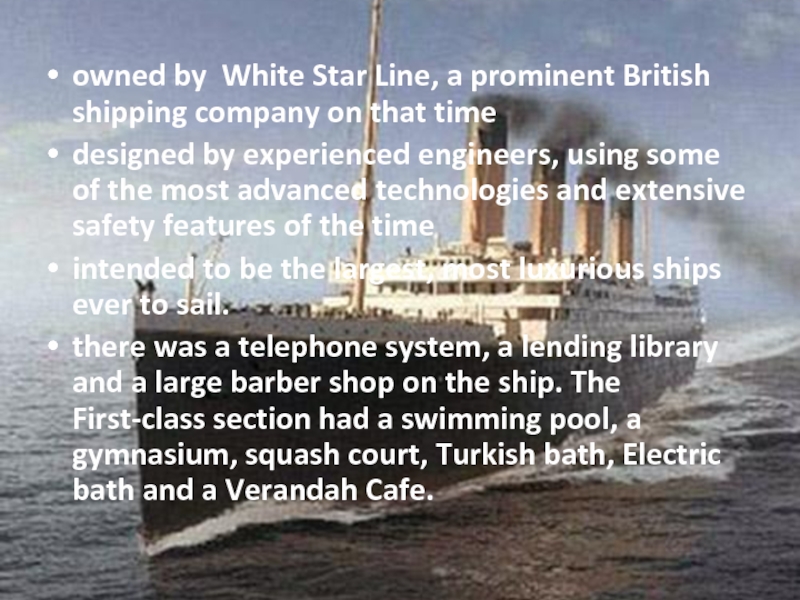
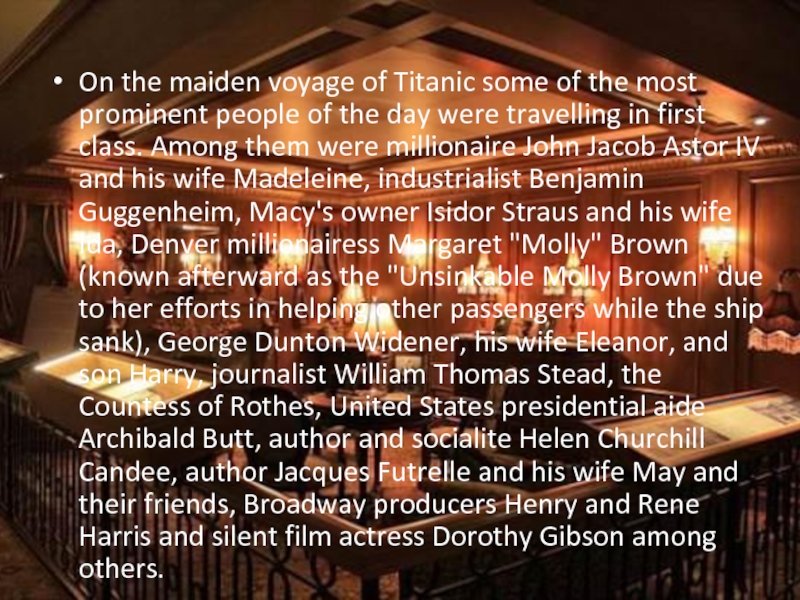
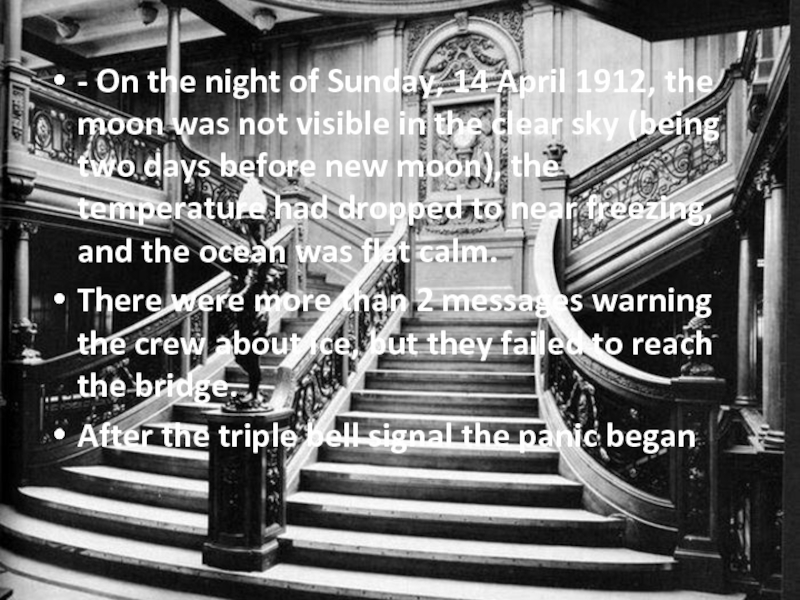
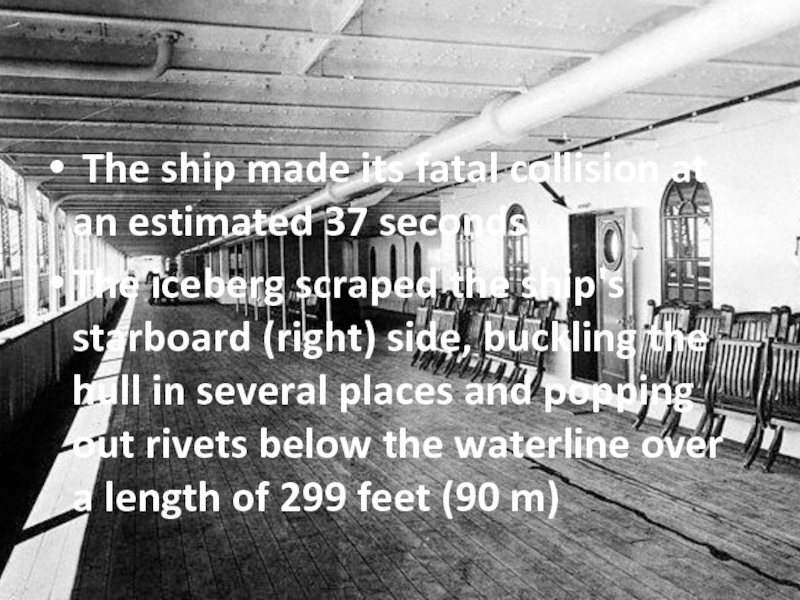
![Titanic For her maiden voyage, Titanic carried a total of 20 lifeboats For her maiden voyage, Titanic carried a total of 20 lifeboats of three different varieties:[30]Lifeboats 1 and](/img/thumbs/4405010d81ab76db025d7c4e5e9f7fb1-800x.jpg)
